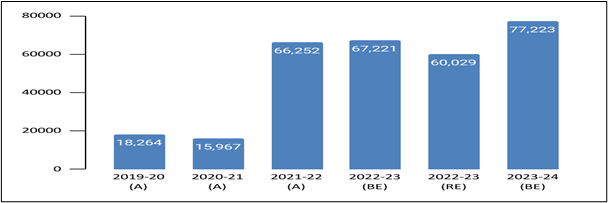
While budgetary allocations and infrastructural growth show an upward trend for water and sanitation, there are loopholes in its functioning and effective implementation.
Published on: 22/05/2023
This blog has been written by Swarupa Das and Trisha Agarwala, Centre for Budget and Governance Accountability
India has made commendable progress in the field of sanitation and water since the launch of the Swachh Bharat Mission (SBM) and the Jal Jeevan Mission (JJM), the flagship schemes of the Government of India, launched in 2014 and 2019, respectively. SBM has continued to grow in its aims and objectives with the launch of Phase II in 2020, with the aim of sustaining the open defecation free (ODF) status of all villages and accrediting them as ODF Plus by 2024-25. Both programmes have received considerable impetus from the Union Government as can be seen in the budget allocation for the Department of Drinking Water and Sanitation (DDWS) (Fig 1). Currently, 62% of households in rural India have tap water connections, 40 percent of India’s inhabited villages have declared themselves ODF Plus. As noteworthy as this sounds, it needs to be assessed if the rate of progress is on par with the targets set for 2024-25, or if it is consistent towards India’s journey of achieving UN SDG 6 of “ensuring availability and sustainable management of water and sanitation for all”.
Figure 1: Budget allocation for Drinking Water and Sanitation from 2019-20 to 2023-24 (in Rs. Crore)
Urban sanitation has been largely overlooked, however, this year’s budget shows a welcome change. While the budget allocation for SBM-R remains unchanged since the previous year, a much needed impetus has been given to SBM-U 2.0 in its Phase II along with AMRUT 2.0 to achieve the goals of garbage free and water secure cities. The rise is clearly reflected in the 54 percent increase in budget allocation (Fig 2). The scope of the scheme was further amplified by the Finance Minister’s budget speech wherein she said that “cities would be enabled for 100 percent mechanical desludging of septic tanks and sewers”.
Figure 2: Budget allocation for SBM-R (rural) and SBM-U (urban) from 2019-20 to 2023-24 (in Rs. Crore)
JJM received high priority in the budget allocations of 2023-24 with a 15 percent increase over the previous year (Fig 3). Marking its relevance in ensuring drinking water for all, the scheme accounts for almost 91 percent of the allocation for drinking water and sanitation. It aims to provide individual tap connections to all households of rural India and has a significant impact on improving the quality of life, addressing longstanding health concerns, thus working as a vital instrument of public health. As of 2nd February 2023, the scheme has provided tap water connections to over 11 crore households, achieving an increase in coverage of 57 percent since its inception in 2019.
Figure 3: Budget allocation for Jal Jeevan Mission from 2019-20 to 2023-24 (in Rs. Crore)
Despite a rise in the budgetary provisions, the Standing Committee on Water Resources – 2021-22, in its 16th report pointed out the dismal fund utilisation figures. In case of JJM, the underutilisation also creates a regional divide in the reach of the scheme as some of the states such as Tripura show a utilisation rate of 77.4 percent while the state of Bihar struggles at 6.8 percent. The Committee while reflecting on this, also recommended better planning and coordination among states to achieve effective utilisation.
While budgetary allocations and infrastructural growth show an upward trend for JJM and SBM, there are loopholes in its functioning and effective implementation. Deep rooted cultural taboos such as menstrual hygiene management and use of toilets present challenges for achieving a mass-movement against unhygienic practices. Paired with these is the continuous challenge of the technology upgrade required for solid and liquid waste management (SLWM) and the consequent capacity building required for executing it. As the country enters the second phase of SBM-R, the DDWS faces multiple constraints due to the new interventions for SLWM under phase II. Additionally, there are problems in convergence between departments. The DDWS also has to ensure better coordination with urban counterparts so that it can access existing resources for plastic sludge management and faecal sludge management.
To complement the flagship schemes of JJM and SBM, the Government of India has initiated several programmes such as: Swachh Survekshan Grameen (SSG), a ranking exercise on the basis of performance on key indicators of SBM-R, and ‘Retrofit to twin-pit campaign’ that aims to retrofit the single-pit toilets into twin-pit toilets in an attempt to enable more hygienic practices of sanitation through better technology. The Government also supplemented the JJM with Mission Amrit Sarovar on 24th April 2022 which follows a 'whole of society' approach, wherein the Ministries of Rural Development, Jal Shakti, Panchayati Raj, and Environment, Forest and Climate Change have cooperated with technical assistance from the Bhaskaracharya National Institute for Space Applications and Geo-Informatics (BISAG-N) with the aim of developing and rejuvenating 75 water bodies in each district during the country's 75th year of independence. Similarly, a JALDOOT app was launched on 27th September 2022 to measure the water level in a Gram Panchayat through 2-3 selected open wells twice a year (pre-monsoon and post-monsoon).
Against the backdrop of these challenges such as fund utilisation and inter-departmental convergence, coupled with the ever-increasing demands of a growing population, the new initiatives can help bring in innovative technologies and better techniques to monitor the progress of the schemes.
At IRC we have strong opinions and we value honest and frank discussion, so you won't be surprised to hear that not all the opinions on this site represent our official policy.